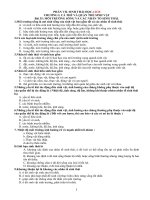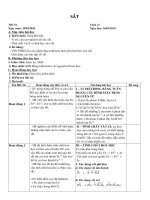macroeconomic mcgrowhill macro ch 7 19e use this one
Bạn đang xem bản rút gọn của tài liệu. Xem và tải ngay bản đầy đủ của tài liệu tại đây (261.66 KB, 26 trang )
McGraw-Hill/Irwin
Chapter 7
Measuring
Domestic Output
and National
Income
Copyright © 2009 by The McGraw-Hill Companies, Inc. All
Chapter Objectives
•
•
•
•
•
Define and measure GDP
GDP and income relationships
The GDP price index
Nominal GDP vs. real GDP
Limitations of the GDP measure
24-2
National Income Accounting
• Bureau of Economic Analysis
compiles National Income and
Product Accounts
– Assess health of economy
– Track long run course
– Formulate policy
24-3
Gross Domestic Product
• Measure of aggregate output
• Monetary measure
• Avoid multiple counting
– Market value final goods
– Ignore intermediate goods
– Count value added
24-4
Gross Domestic Product
• Exclude financial transactions
– Public transfer payments
– Private transfer payments
– Stock (and bond) market
transactions
• Second hand sales
– Sell used car to a friend
24-5
Two Approaches to GDP
• Income approach
– Count income derived from
production
– Wages, rental income, interest
income, profit
• Expenditure approach
– Count sum of money spent buying
the final goods
– Who buys the goods?
24-6
Two Approaches to GDP
Consumption by
Households
Wages
Investment by
Businesses
Rents
+
+
Government
Purchases
+
Expenditures
By Foreigners
G
= D=
P
+
+
+
+
Interest
Profits
Statistical
Adjustments
24-7
Expenditure Approach
• Personal consumption
expenditures (C)
– Durable consumer goods
– Nondurable consumer goods
– Consumer expenditures for
services
– Domestic plus foreign produced
24-8
Expenditure Approach
• Gross private domestic
investment (I)
– Machinery, equipment, and tools
– All construction
– Changes in inventories
• Creation of new capital asset
• Noninvestment transactions
24-9
Expenditure Approach
-
Gross Investment
Depreciation
= Net Investment
Gross
Investment
Net
Investment
Depreciation
Increase
Stock of
Capital
Consumption
& Government
Spending
January 1
Year’s GDP
Stock of
Capital
December 31
24-10
Expenditure Approach
• Government purchases (G)
– Expenditures for goods and services
– Expenditures for social capital
– Excludes transfer payments
• Net exports (Xn)
– Add exported goods
– Subtract imported goods
– NX = exports - imports
• GDP = C+Ig+G+Xn
24-11
U.S. Economy 2009
In Billions
Receipts
Expenditures Approach
Allocations
Income Approach
Personal Consumption (C) $10,089
Compensation
$ 7792
Gross Private Domestic
Rents
268
788
Investment (Ig)
1628
Interest
Government Purchases (G)
2931
Proprietor’s Income
1041
Net Exports (Xn)
-392
Corporate Profits
1309
Taxes on Production and
Imports
National Income
1090
$12,288
Net Foreign Factor Income (-)
105
Statistical Discrepancy (+)
209
Consumption of Fixed
Capital (+)
Gross Domestic Product $ 14,256
LO2
Gross Domestic Product
1864
$ 14,256
7-12
Comparative GDP
LO2
7-13
Components of National Income
•
•
•
•
•
Compensation of employees
Rents
Interest
Proprietor’s income
Corporate profits
– Corporate income taxes
– Dividends
– Undistributed corporate profits
• Taxes on production and imports
24-14
Income Approach
• From national income to GDP
– Net foreign factor income
– Statistical discrepancy
– Consumption of fixed capital
• Other national accounts
– Net domestic product (NDP)
– National income (NI)
– Personal income (PI)
– Disposable income (DI)
– DI = C + S
24-15
U.S. Income Relationships 2009
Gross Domestic Product (GDP)
Less: Consumption of Fixed Capital
Equals: Net Domestic Product (NDP)
Less: Statistical Discrepancy
Plus: Net Foreign Factor Income
Equals: National Income (NI)
Less: Taxes on Production and Imports
Less: Social Security Contributions
Less: Corporate Income Taxes
Less: Undistributed Corporate Profits
Plus: Transfer Payments
Equals: Personal Income (PI)
Less: Personal Taxes
Equals: Disposable Income (DI)
LO2
$ 14,256
1864
$ 12,392
209
105
$ 12,288
1090
967
315
418
2528
$ 12,026
1102
$ 10,924
7-16
Class Exercise
Form groups of 4 to 5 students.
Working together, and using the
data listed on the board solve for
GDP, NPD, NI, PI and DI (use
Expenditure Approach for GDP)
Each group should assign a
spokesperson to review the
solution with the class…….
24-17
•Transfer Payments $16 (Dollars in Billions)
•Government Purchases 80
•Personal Taxes 38
•Corporate Income tax 28
•Taxes on Production and Imports 15
•Social Security contributions 8
•Undistributed corporate profits 19
•Proprietor’s income 25
•Compensation of employees 258
•Personal consumption expenditures 322
•Consumption of fixed capital 4
•Rents 10
•U.S. Exports 14
•Corporate profits 70
•Interest 12
•Dividends 23
•Imports to U.S. 17
•Gross private domestic investment 63
•Net foreign factor income 10
•Statistical Discrepancy 35
24-18
Nominal vs. Real GDP
• GDP is a dollar measure of
production
• Using dollar values creates
problems
• Nominal GDP
– Use prevailing price
• Real GDP
– Reflect changes in price
– Use base year price
24-19
GDP Price Index
• Use price index to determine real
GDP
Price
Index
In Given =
Year
Real
GDP
=
Price of Market Basket
In Specific Year
Price of Same Basket
In Base Year
x 100
Nominal GDP
Price Index (in hundredths)
24-20
NOMINAL GDP vs. REAL GDP
Nominal Values
• Deflate GDP when prices rise
• Inflate GDP when prices fall
• Nominal GDP
• Calculating Real GDP
(4)
(2)
(3)
Unadjusted,
(5)
(1)
Price Price Index or Nominal, Adjusted,
Units of Pizza
Year 1 =
GDP,
Or Real,
Year Output Per Unit
100
GDP
(1)x(2)
1
2
3
4
5
5
7
8
10
11
$ 10
20
25
30
28
100
200
250
-
$ 50
140
200
-
$ 50
70
80
-
24-21
Shortcomings of GDP
•
•
•
•
•
•
Nonmarket activities
Leisure
Improved product quality
The underground economy
GDP and the environment
Composition and distribution of the
output
• Noneconomic sources of well-being
24-22
Underground Economy
As a percentage of GDP, Selected
Nations, 2007
0
Mexico
South Korea
India
Italy
Spain
China
Sweden
Germany
France
United Kingdom
Japan
Switzerland
United States
5
Percentage of GDP
10
15
20
25
30
Source: Open Assessment, E-Journal
24-23
Sources of BEA Data
• Consumption
– Census Bureau’s Retail Trade Survey
– Census Bureau’s Survey of Manufacturers
– Census Bureau’s Service Survey
• Investment
– All Consumption data sources
– Census Bureau’s Housing Starts Survey and
Housing Sales Survey
– Retail Trade Survey
– Wholesale Trade Survey
– Survey of Manufacturing
24-24
Sources of BEA Data
• Government Purchases
– Office of Personnel Management
– Construction Surveys
– Census Bureau’s Survey of
Government Finance
• Net Exports
– U.S. Customs Service
– BEA Surveys and Analysis
24-25









